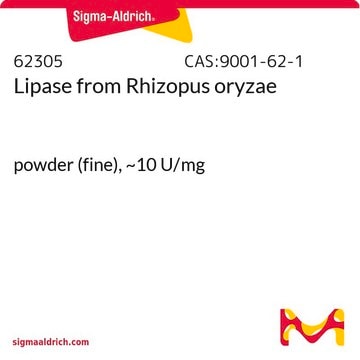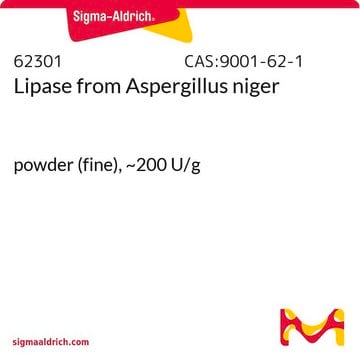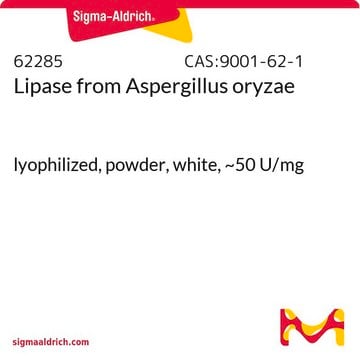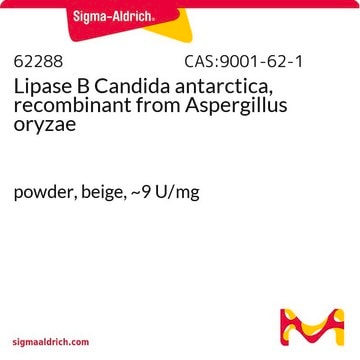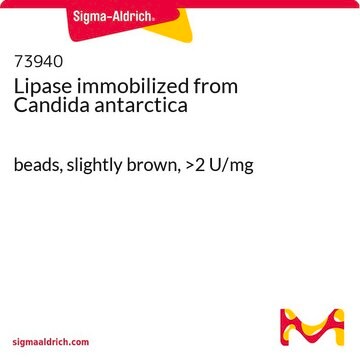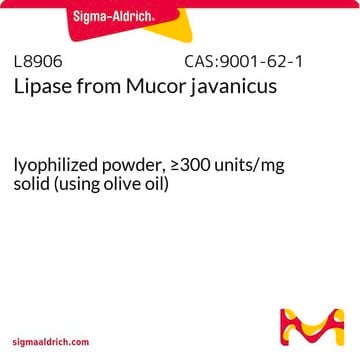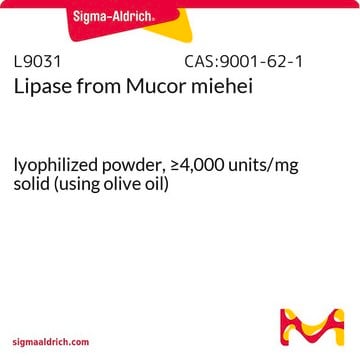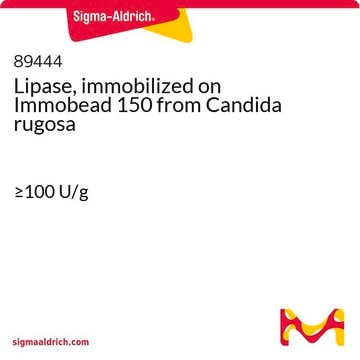80612
Lipase from Rhizopus oryzae
powder, light brown, ≥30 U/mg
Sinônimo(s):
Lipase F-AP 15
Selecione um tamanho
About This Item
Produtos recomendados
fonte biológica
fungus (Rhizopus oryzae)
forma
powder
atividade específica
≥30 U/mg
cor
light brown
temperatura de armazenamento
2-8°C
InChI
1S/C11H9N3O2.Na/c15-8-4-5-9(10(16)7-8)13-14-11-3-1-2-6-12-11;/h1-7,16H,(H,12,14);/q;+1/b13-9-;
chave InChI
QWZUIMCIEOCSJF-CHHCPSLASA-N
Descrição geral
Aplicação
- to replace rabbit gastric extract for infant in vitro digestion[3]
- in the two-phase lipase-catalyzed system for the enzymatic preparation of biodiesel[4]
- in the simulation of infant gastrointestinal digestion in vitro, focusing on the characteristics of emulsions during digestion to replicate the stomach environment and adjust the emulsion pH[5]
Ações bioquímicas/fisiológicas
These enzymes are widely used to modify the structure of oils and fats, tailoring natural lipids to meet specific properties useful for food, nutrition, and cosmetic applications. Lipases from filamentous fungi families, such as Rhizopus oryzae are extensively utilized in the oil and fats industry due to their high 1,3-regioselectivity toward triglycerides, making them versatile in lipid modification.[2] Lipases are used industrially for the resolution of chiral compounds and the transesterification production of biodiesel.
Definição da unidade
Nota de análise
the optimum temperature is 40°C, the optimum pH is 7.2 (highly active from pH 6.5-7.5)
Palavra indicadora
Danger
Frases de perigo
Declarações de precaução
Classificações de perigo
Resp. Sens. 1
Código de classe de armazenamento
11 - Combustible Solids
Classe de risco de água (WGK)
WGK 1
Ponto de fulgor (°F)
Not applicable
Ponto de fulgor (°C)
Not applicable
Equipamento de proteção individual
Eyeshields, Gloves, type N95 (US)
Certificados de análise (COA)
Busque Certificados de análise (COA) digitando o Número do Lote do produto. Os números de lote e remessa podem ser encontrados no rótulo de um produto após a palavra “Lot” ou “Batch”.
Já possui este produto?
Encontre a documentação dos produtos que você adquiriu recentemente na biblioteca de documentos.
Os clientes também visualizaram
Active Filters
Nossa equipe de cientistas tem experiência em todas as áreas de pesquisa, incluindo Life Sciences, ciência de materiais, síntese química, cromatografia, química analítica e muitas outras.
Entre em contato com a assistência técnica